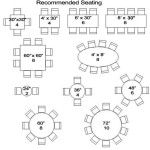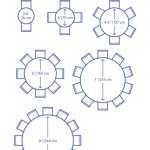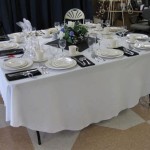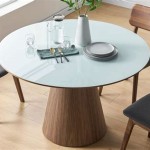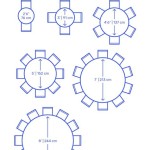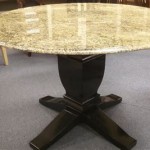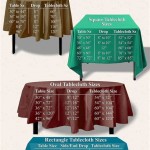What Length Dining Table Seats 6?
Selecting the right dining table involves careful consideration of several factors, primarily the number of people it needs to accommodate and the available space within the dining area. Determining the appropriate length for a dining table designed to seat six individuals is crucial for ensuring comfortable seating and adequate space for dining. This article will delve into the specifics of dining table dimensions required for seating six people, exploring various shapes and considerations to optimize the dining experience.
The length of a dining table designed to seat six people is not a fixed number but rather a range dependent on the shape of the table. Factors such as the width of individual place settings, the space needed for serving dishes, and the comfort level desired per person all influence the optimal length. Understanding these variables is paramount for making an informed decision when purchasing or commissioning a dining table.
Standard Dimensions for a Rectangular Dining Table
A rectangular dining table is a common choice for seating six people due to its versatility and efficient use of space, especially in narrower dining rooms. The ideal length for a rectangular table seating six ranges from 60 inches to 72 inches (5 feet to 6 feet). This length allows for three people to be seated comfortably on each side, providing ample elbow room and space for place settings.
Specifically, a 60-inch rectangular table provides a minimum of 20 inches of space per person, a generally accepted standard. However, a 72-inch table offers a slightly more generous 24 inches per person, which can significantly enhance the dining experience, particularly if serving multiple courses or using larger dinnerware. The width of the table also plays a crucial role; a standard width of 36 inches to 42 inches ensures enough space for serving dishes in the center without encroaching on individual dining areas. Tables narrower than 36 inches can feel cramped, while those wider than 42 inches can make it difficult to reach serving dishes.
When calculating the dimensions, consideration should be given to the style of chairs being used. Chairs with arms will require more space than armless chairs. Ensuring that the chairs can be comfortably pushed back from the table without bumping into walls or other furniture is also essential for comfortable use of the dining area. Furthermore, the table's legs should be positioned in a way that does not interfere with legroom for those seated.
For formal dining occasions, a slightly larger table might be preferred to accommodate extensive serving platters and elaborate place settings. Conversely, for casual, everyday use, a slightly smaller table might be adequate. The overall aesthetic of the dining room and the desired ambiance should also be considered when selecting the size of the rectangular dining table.
Circular and Oval Dining Table Considerations
Circular and oval dining tables offer a different aesthetic compared to rectangular tables and can be suitable for square dining rooms or spaces where a softer, more intimate atmosphere is desired. For seating six people, a circular dining table should have a diameter of at least 48 inches. This diameter provides approximately the same amount of personal space as a 60-inch rectangular table. However, a diameter of 54 inches to 60 inches is generally preferred for added comfort and easier access to serving dishes in the center.
An oval dining table, being an elongated circle, provides a compromise between the space efficiency of a rectangular table and the aesthetic appeal of a circular table. For seating six, an oval table should ideally be between 60 inches and 72 inches in length, similar to a rectangular table. However, the width can be slightly less, usually around 36 inches to 40 inches, due to the absence of sharp corners. The oval shape can facilitate conversation and create a more inclusive dining experience.
One advantage of both circular and oval tables is that they do not have corners, which can be helpful in smaller spaces where navigating around the table is necessary. However, circular tables can sometimes be less efficient in terms of wall placement, as they require more open space around them. Oval tables, on the other hand, can be pushed closer to a wall if needed, offering more flexibility in room layout.
When selecting a circular or oval table, it is important to consider the base. A pedestal base can provide more legroom than four individual legs, especially for a circular table. The material of the base should also be sturdy and stable to prevent the table from wobbling. The overall design of the table should complement the style of the chairs and the overall decor of the dining room.
Moreover, accessibility to the center of the table is a key consideration with circular and oval shapes. A lazy Susan can be a practical addition to facilitate easy sharing of dishes among diners, particularly on larger circular tables where reaching across the table can be challenging.
Additional Space and Ergonomic Factors
Beyond the dimensions of the table itself, adequate space around the table is crucial for comfortable movement. A minimum of 36 inches of clearance between the edge of the table and any walls or furniture is recommended. This allows individuals to comfortably pull out their chairs and walk around the table without obstruction. In tighter spaces, 30 inches may be acceptable, but it can feel somewhat restrictive.
Ergonomics also play a significant role in the dining experience. The height of the dining table should be appropriate for the height of the chairs being used. A standard dining table height is between 28 inches and 30 inches. The chairs should allow individuals to sit comfortably with their feet flat on the floor and their knees at a 90-degree angle. The height of the chair seat should be approximately 12 inches lower than the table height to provide adequate legroom.
Lighting is another factor that can impact the dining experience. Adequate lighting above the table enhances visibility and creates a more inviting atmosphere. A chandelier or pendant light centered above the table can serve as both a functional and decorative element.
Furthermore, the flooring around the dining table should be considered. A rug placed under the table can help to define the dining area and add warmth to the space. However, the rug should be large enough to accommodate the chairs when they are pulled out from the table to prevent them from catching on the edge of the rug. The rug should also be easy to clean and maintain to avoid stains from spills.
Ultimately, the selection of a dining table that comfortably seats six involves a balance of size, shape, and ergonomic considerations. Careful planning and attention to detail can ensure a functional and enjoyable dining space.
The material of the table also contributes to the overall ambiance. Wood tables offer a classic and warm feel, while glass tables can create a more modern and open look. Metal tables are durable and can be suitable for contemporary settings. The choice of material should align with the overall style of the dining room and the desired aesthetic.
Finally, it's always beneficial to measure the dining space accurately before making a purchase. This will help to ensure that the table fits comfortably in the room and that there is enough space for movement around it. Using painter's tape to mark out the dimensions of the table on the floor can be a helpful way to visualize how the table will fit in the space.

How To Choose The Right Dining Table Size And Shape Contemporary Wooden Furniture Hand Made In Cincinnati Ohio Modern Traditional Craft

Standard Chair Heights And Dining Table Size Guide

Table Size Seating Capacity Round Rectangular More

Complete Guide To Patio Tables Bonus Styling Tips

Seating Capacity For Round Rectangular Tables

Standard Dining Table Dimensions The Size Guide

Table Seating Capacity Contemporary Craftsman Furniture

Stonehollow White Gray Dining Table And Chairs With Bench Set Of 6 Luna Furniture

60 Vs 66 Inch Choosing The Best Dining Table Size For 6 Chairs

Choosing The Right Dining Table Size Your Ultimate Guide Cabinfield Blog
Related Posts


